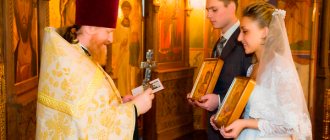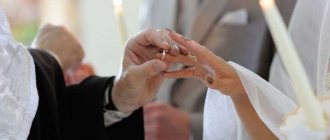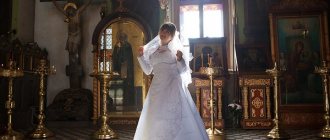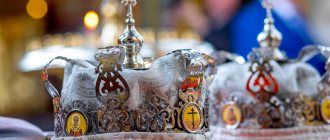Peculiarities
From the point of view of the Catholic Church, a sacrament is characterized by:
- holiness is the connection of two people with God;
- unity - the union of spouses into one whole;
- indissolubility - the eternity of the marriage union even in the afterlife; Divorce is possible in very rare cases.
Interesting! In Christianity, the family, that is, the church union of a man and a woman, is called the “small” or “domestic church.”
A wedding that is like a theatrical performance
What is a Catholic wedding? This sacrament assumes that the bride and groom are previously engaged for a church wedding. Unlike Orthodox worshipers of God, for Catholics a wedding is equivalent to such a concept as a wedding. Before the ceremony, both the bride and groom are required to take two steps:
- confess to the Lord;
- take communion in order to be pure in God’s eyes.
Then comes a charming moment, the day of the wedding sacrament.
The bride on this day is dressed in a shining snow-white, clean outfit. The groom is overwhelmed with excitement from the expectations and trepidation of this day. And so, the father of the bride passes the hand of his beloved daughter, standing at the altar, to the loving groom. This suggests that the couple will soon become one body, one heart, and one spirit. This newly formed family will take care of each other all their lives, giving their attention and warmth only to their other half.
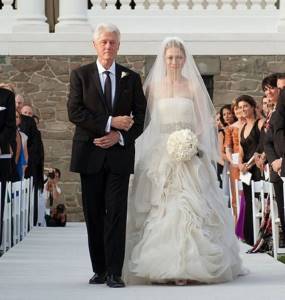
Children play a huge role during a wedding. The girls from the guests are dressed up in white outfits, wedding dresses, especially so that they are a symbol of the purity and purity of love between a man and a woman who are creating a family. The bride and groom may have witnesses to enter into a sacred union. The beauty of the ceremony is given by the fact that the girls, the bride's friends, dress up in identical dresses, and the groom's friends in identical suits. Basically, the wedding sacrament is performed by a clergyman worthy of God. But there are exceptions when an ordinary layman can do this. How exactly does the designated person perform this mysterious Catholic wedding?
First of all, the clergyman or layman conducting the sacrament reads a prayer in front of everyone, turning the Lord’s gaze to the young and happy couple, yearning for his approval.
Then, the couple goes through the process of communion.
Afterwards, the appointed representative of the couple before God asks a very important question to all the guests present at this event. He wonders if there are any reasons for the marriage of two loving hearts to fail. If there are no reasons preventing the foundation of the marriage, the sacrament continues further.
During the ceremony, everyone present, and the couple of lovers too, of course, sit on certain special chairs.
One of the most important moments of a wedding is the period when the bride and groom take vows, oaths of fidelity and devotion to each other. The words of the vow are not spontaneous utterances, but a pre-prepared, thoughtful speech. As a result, the ceremony is decorated with sincerity and the beauty of the vows of the bride and groom. Such confessions are very tender and touching.
The groom receives the rings from the hands of his main witness. Afterwards, the newlyweds exchange rings and put signatures confirming their love in the book of the Catholic Church.
Now, the priest can safely, with a clear conscience, declare the couple husband and wife.
What pleasant emotions, at this moment, can be experienced by those who five minutes ago were just a bride and groom, and now they are, according to the law, and before God, a worthy family who wants to carry their love and tenderness throughout their lives. How glad the parents of these people are that they raised such wonderful, God-fearing children, striving to please not only them, but also the heavenly supreme Father.
Yes, being husband and wife for lovers is now a great honor and responsibility. They are eager to behave like a family that deserves respect.
The feelings of the couple are shown by their happy eyes, the constant desire to hug each other, without parting not only on this day, but throughout their entire adult life.
Terms and Conditions
In order to adequately prepare for the wedding ceremony, future spouses must meet several conditions:
- contact the clergyman of the parish where they intend to conduct the marriage ceremony 3 months before the wedding;
- be in an officially registered marriage;
- undergo special pre-marital preparation.
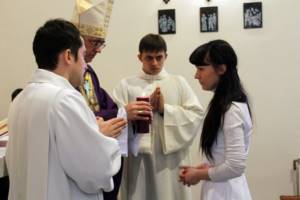
You need to know the basic prayers and rituals of the Catholic Church:
- "Our Father";
- "Symbol of faith";
- "To the Virgin Mary";
- gospel commandments;
- 6 truths of faith;
- 5 church commandments;
- "Angel of the Lord";
- Holy Rosary;
- order of baptism;
- church sacraments;
- preparing the home for the sacrament of the sick;
- 5 conditions for the sacrament of reconciliation.
Preparation for the wedding
Catholics know that they must come to the church three months before the ceremony. During this period, the newlyweds prepare for their wedding in the Catholic Church. The priest tells them about marriage from a Catholic perspective. There is even a special book on how to conduct ten meetings with newlyweds who want to get married according to the Catholic rite.
During this unique training before a Catholic wedding, young people learn the understanding of family in the Catholic faith and, if they didn’t know, the prayers: “Our Father,” “To the Virgin Mary,” “I Believe.”
The priests believe that such a “school” is very important for young people because the Catholic faith is very strict. For example, a great sin is the use of contraceptives (condoms, IUDs, pills). The newlyweds are explained the sinfulness of these methods and told about the natural method of family planning, from the perspective of the Catholic faith.
The wedding takes place only after the marriage has been registered.
Preparation
At the first meeting with the priest, the newlyweds (they are also called the betrothed) agree on the procedure for taking special pre-marital courses to get acquainted with the Catholic foundations of marriage, family, and the role of spouses in raising children.
Thus, the Catholic Church is categorically against the use of any contraception and considers it a great sin. Only the physiological method of planning the birth of a child is acceptable.
The need for active participation in the life of the church, observance of Christian commandments, and introducing children to the faith is discussed. Usually there are 10 such conversations.
Interesting! In the Catholic tradition, there is a custom of engagement, that is, young people notifying their family and friends of their intention to marry.
The bride and groom must prepare and undergo the sacraments of confession and Eucharist (communion), which are preceded by fasting.
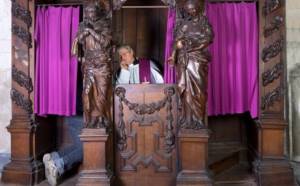
Features of an Orthodox wedding
The Orthodox wedding ceremony implies the full consent of the bride and groom to take an oath of fidelity to each other, as well as receiving from the church the blessing of their union, the birth and upbringing of children in accordance with the traditions of a Christian society.
The ceremony consists of two parts: the engagement and the wedding itself. Initially, these two processes took place separately from each other, but by the end of the 17th century they were combined. During the engagement process, the priest puts wedding rings on the bride and groom as a symbol of their endless, eternal and boundless love. The spouses, as a sign of their consent, must exchange rings three times, after which one ring remains with the bride, and the second with the groom.
After the betrothal, the priest uses a crown to signify the bride and groom with a cross. The spouses are presented with a cup of red wine, which symbolizes their common destiny, and the newlyweds alternately drink all the wine in three doses. Next, the priest joins the right hands of the newlyweds and circles them three times around the lectern. This is a symbol of the beginning of a joint journey.
At the end of the ceremony, the bride and groom kiss the icons of the Mother of God and the Savior, receive from the priest two icons prepared in advance by the parents of the spouses, and the wedding ceremony ends.
Betrothal of young people of different faiths
The most common situation is when both spouses belong to the Catholic Church. In this case, there are no canonical obstacles to marriage. But it happens that one of them is a representative of another religion. In this case, there are a number of peculiarities during a wedding.
Catholic and Orthodox or Protestant
If one of the betrothed belongs to another Christian denomination (Orthodoxy, Protestantism), then permission for such a marriage is given by the bishop of the corresponding diocese.
Important! Catholicism also recognizes as legal marriages performed in the Orthodox Church.
The newlyweds make a promise to raise their future children in the Catholic faith. Information about the married couple and the signatures of the spouses under such a promise are entered in a special form.
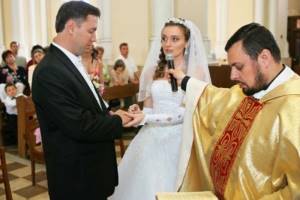
Wedding with an unbaptized person
If one of the spouses is unbaptized (atheist, Jew, Muslim, Buddhist), that is, does not belong to Christianity, then obtaining permission from the bishop becomes much more difficult. There is no canonical ban on such marriage, but each case is considered individually. The clergyman talks with the newlyweds about the difference in cultures and the possible difficulties of such a union.
The final decision rests with the bishop.
Orthodoxy and Catholicism

Orthodoxy is one of the main directions in Christianity. And Catholicism is one of the three main Christian denominations. The division into Orthodoxy and Catholicism occurred back in 1054.
In Orthodoxy, there is the possibility of remarriage if the party was not guilty of the divorce. At the same time, it is possible to enter into marriage not only for the second, but also for the third time. As for Catholicism, marriage is indissoluble.
If a couple has entered into a sacred union, then it remains inviolable. One of the common features of Orthodoxy and Catholicism is that both directions have an identical idea of \u200b\u200bthe family. Another similarity is the categorical rejection of homosexual marriage.
The right time
The sacrament of wedding according to the Catholic rite is performed almost all year round. The spouses themselves usually prefer to get married outside of fasting days, but there is no direct prohibition on this.
When getting married during Lent, you should not have a loud celebration after the ceremony with many competitions and a noisy feast.

Who shouldn't get married?
Wedding ceremonies in the Catholic Church are not performed for blood relatives, as well as for people married to a third party. Here, too, there is a difference from Orthodoxy. There is no divorce (debunking) in the Catholic Church. If one of the newlyweds was previously married, even in the Orthodox Church, he cannot be married according to the Catholic rite.
During preparations for the wedding, the priest asks the newlyweds questions, trying to find out possible obstacles to marriage. Impotence of one of them may also be such an obstacle. Moreover, it is clarified that it is the inability to have sexual intercourse, and not infertility. A marriage is considered invalid if the priest performed the wedding ceremony without knowing about this fact.
Prohibitions on weddings in churches
The performance of the sacrament of wedding is prohibited in the following cases:
- those intending to enter into a church marriage are relatives (father and daughter, brother and sister) or half-brother and sister;
- one of the possible spouses is already in a church marriage;
- the physical impossibility of one of the spouses to perform marital duties, but infertility is not an obstacle to participation in the wedding;
- the murder of a husband or wife by one of the spouses for the sake of entering into a new marriage;
- the intended ones are cousins (theoretically, such a union is possible with the permission of the bishop, but in practice it is issued in exceptional cases);
- one of those wishing to marry is a clergyman or monk (nun).
Even if the wedding sacrament was performed, and the circumstances listed above later became clear, the ceremony is considered invalid.
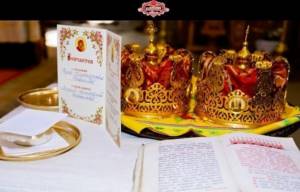
After a divorce (without a previous wedding), you must provide a certificate of divorce.
On formalizing relations with non-Orthodox people
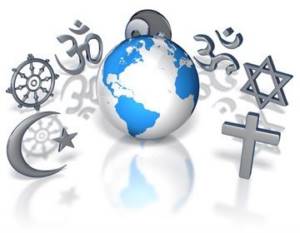
First you need to understand what the concept of “heterodox” is. This is the name of non-Orthodox Christian confessions, which include Catholicism, Protestantism, and Armenian-Gregorianism.
It must be remembered that the clash of approaches that were adopted in the Catholic and Orthodox churches and, in some cases, so different in solving intra-family problems when marrying between representatives of different religious denominations can lead to difficult situations in the family.
If you pay attention to the church practice of recent centuries, the Orthodox Church allows marriages between Catholics and Orthodox Christians . Moreover, the church allows union only with those Christians whose baptism it recognizes.
The latter, upon entering the fence of the Orthodox Church, are received in the second or third order - in other words, through Repentance and Confirmation. This includes Catholics, Protestants, Old Believers, and Ancient Eastern Christians. Only if all conditions are met can the Sacrament of Marriage be performed and such a marriage will be recognized as valid.
As for Catholic marriages, this faith allows weddings not only between Catholics, but also if one of the parties is a non-Christian. For a wedding in the Catholic Church, it is enough that at least one of the future spouses is a Catholic.
Dear readers! To solve your problem right now, get a free consultation
— contact the duty lawyer in the online chat on the right or call: +7 Moscow and region.
+7 St. Petersburg and region. 8 Other regions of the Russian Federation You will not need to waste your time and nerves
- an experienced lawyer will take care of all your problems!
Ceremony in the church
There is no strictly regulated ritual order that is uniform for all dioceses. It may vary depending on the area and the priest who performs the wedding. However, a number of characteristic details still exist.
The ceremony is performed by a clergyman. In special cases, he can be replaced by a pious layman.

Start
Usually the wedding ceremony takes place in a church. As a rule, the bride is brought to the altar by her father or another man who has taken upon himself the responsibility of caring for her (uncle, older brother). They are followed by little girls who scatter flower petals from a basket. At this time, the groom with witnesses and other guests is waiting for his future wife in the temple.
Less often, newlyweds enter the church together, holding hands. The bride is not required to wear a wedding dress, and the groom is not required to wear a suit. All that is required is the observance of neatness corresponding to the solemnity of the sacrament. At the altar, the betrothed stand or sit on special chairs with cushions.
Catholic tradition requires the participation of witnesses (up to three people on each side). Witnesses may belong to any Christian denomination. Bridesmaids often wear matching dresses. A special role is given to a little girl from among the guests, who is dressed up in a wedding dress. It symbolizes the purity, purity and spirituality of the future marriage union.
Liturgy
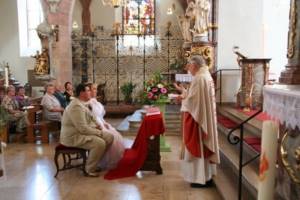
The wedding ceremony is preceded by a liturgy, after which the priest reads small fragments from the Bible and delivers a sermon on the importance of church marriage, the role of each spouse in the family, and the need for careful upbringing of children.
Then the couple getting married has a conversation with the clergyman, during which he asks the future spouses questions about the presence of any obstacles to getting married:
- Did you come to the temple voluntarily, and is your desire to enter into a legal marriage sincere and free?
- Are you ready to remain faithful to each other in sickness and in health, in happiness and in misfortune, until the end of your life?
- Do you intend to lovingly and gratefully accept the children God sends you and raise them according to the teachings of the church?
These questions make it possible to verify the sincere and free desire of the young people, their Christian view of the sacrament of wedding and family ties.
Vows and engagement
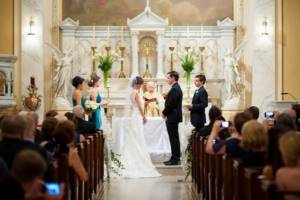
Interesting! Previously, in the Catholic Church there was a custom to decorate the temple gates with metal ringing objects to attract good luck to the future family.
After the oath, the groom's main witness hands him the wedding rings, the groom puts the ring on the bride's ring finger, and she puts the ring on the groom's. The priest says the Lord's Prayer, the Intercessory Prayer and blesses the newlyweds. Newly-made spouses sign in the church register.
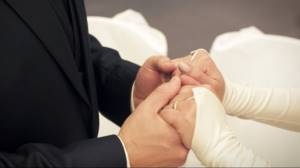
In most Catholic countries: France, Slovenia, Croatia, Czech Republic, Italy, Slovakia, the ring is traditionally worn on the ring finger of the left hand. A wedding ring is worn on the right hand in Poland, Austria, Spain, and Argentina.
The entire sacrament of wedding takes about half an hour.
How and where to get married in a church without registering a marriage
You can get married without registering a marriage at the registry office in Russia in any religious building owned by the Russian Orthodox Church. In this case, it is necessary to convince the clergyman that the desire to enter into a church marriage is sincere and explain why the couple refuses to officially register the union.
The price of the ceremony is about 2000 rubles, not taking into account the cost of paraphernalia (candles, etc.). If you want to perform the ceremony abroad, you must have a certificate from the registry office with you.
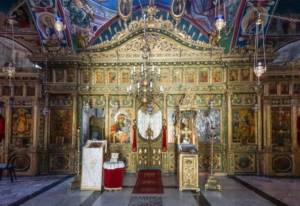
For example, in the Old City in Jerusalem or in the Temple of St. Paraskeva on the embankment in Hersonissos in Greece.
Wedding ceremony
A Catholic wedding begins with liturgy, prayer and a sermon, with which the priest once again emphasizes the importance of this step for the newlyweds.
Afterwards, he asks the newlyweds three questions:
Did you come here voluntarily and freely want to enter into a marital union?
Are you ready to love and respect each other for the rest of your life?
Are you ready to lovingly accept children from God and raise them according to the teachings of Christ and the church?
If the answer to all questions is “yes,” the priest prays for the Holy Spirit to descend on the newlywed couple. After this, the newlyweds say their vows to each other.
At a wedding ceremony in the Catholic Church, you can do without wedding rings. If the newlyweds want, the priest will bless the rings, but the main rite is the pronouncing of the marital vow and receiving grace.
- Wedding plays a vital role in the life of representatives of the Catholic Church. This Christian rite has been known since the 4th century AD. The concepts of “marriage” and “wedding”, in contrast to the Orthodox tradition, are actually identical to the wedding ceremony, therefore, along with the high responsibility of those who decided to go through betrothal in the church, the preparation for the celebration is also very strict.
- holiness
is the connection of two people with God; - unity
- the union of spouses into one whole; - indissolubility
- the eternity of the marriage union even in the afterlife; Divorce is possible in very rare cases.
From the point of view of the Catholic Church, a sacrament is characterized by:
Interesting!
In Christianity, the family, that is, the church union of a man and a woman, is called the “small” or “domestic church.”
Wedding in the Catholic Church: rules, advice and main stages of the sacrament
A wedding is a ceremony that many newlyweds consider the most important in their lives. After all, they represent the conclusion of an alliance in the face of God. It’s worth taking such a step only if you are 100% sure that your partner is “the one” and you are ready to live your whole life with him.
Today the Svadebka.ws portal will tell you about how a wedding takes place in the Catholic Church and will answer such important questions: how to prepare for the sacrament of a wedding in a church, and also whether those who do not belong to the Catholic faith can get married in a church.
Who can get married and who can’t?
Before you start preparing for the sacrament, you should find out in advance which couples will not be married in the church under any circumstances. You will not be married if:
- you are directly related or are each other's half-brother and sister;
- one of the newlyweds is still married;
- one of you is divorced, but was married in a previous marriage (the Catholic Church does not recognize debunking, this is done in the most exceptional cases);
- one of you was convicted of murdering your previous husband/wife;
- you are a clergyman of the Catholic Church.
If the wedding sacrament was performed and you were able to hide one of the above facts, but over time it was discovered, it is considered invalid.
If one of the newlyweds in a couple is Orthodox, then there are no obstacles to getting married. Even if you do not want to convert to the Catholic faith, but want to remain in your own.
The main thing to consider in this case is that you must promise to baptize your children in the Catholic Church. If one of you is a Muslim or a Jew, then everything is much more complicated due to the difference in cultures.
It is necessary to inform about your intention to get married as early as possible.
How to prepare for a Catholic wedding: rules and tips
Like any other church, the Catholic Church has certain rules for couples who want to get married. Let's look at what these rules are:
- You should contact the church in advance. It is advisable to come to the church 3 months before the expected wedding date so that you have time to prepare for the sacrament. If you come several weeks in advance, and even think about whether you need to get married, then there is a high probability that you will be refused.
- You need to attend church meetings. From the moment you informed that you want to get married in a church, conversations are scheduled for you. Usually you need to go to them no more than once a week or two. These conversations are dedicated to preparing for family life and studying prayers. The topic of protection is also discussed separately. The Catholic Church strongly denies the possibility of using contraceptives. You need to be prepared for this.
- You should choose a favorable day for the wedding. You can get married in the Catholic Church at any time, excluding fasting. But, if you have circumstances for which you decided to get married during Lent, then you need to inform the priest about this in advance and promise that there will be no feast. Then there is a high probability that they will meet you halfway and conduct a wedding ceremony, even if Catholics are fasting.
- The marriage must be concluded before the wedding. First, you must schedule the painting at the registry office, and then the Catholic wedding ceremony.
A Catholic wedding begins with the groom waiting for the bride at the altar. Her father or closest relative can bring her to the groom. This moment is one of the most touching in a Catholic wedding. Make sure you have a photographer, the photos will turn out simply magical.
The conduct of the wedding ceremony itself depends on the priest. There is no such scenario. There are certain prayers that the priest must read during the wedding. And there are questions that he will ask the newlyweds:
- Have you come voluntarily and want to conclude this alliance?
- Will you respect and love each other until the end of your days?
- Do you promise to raise your children according to the rules and laws of the Catholic Church?
If any of the newlyweds answer “no” to at least one of the questions asked, the wedding will be stopped immediately.
Well, if the answers are positive, then the priest ties the hands of the newlyweds with a ribbon. At this moment, the couple turns to face each other and pronounces the words of a special oath.
Usually it does not need to be learned by heart, the priest will read it himself, and you only need to repeat it.
Then the couple exchanges wedding rings and the Lord's Prayer is recited. It is worth noting that rings are not mandatory in the church. If you don't want to exchange rings, just let us know in advance. Then the priest blesses the newlyweds, and this ends the sacrament. Typically, the entire Catholic wedding ceremony from start to finish takes no more than half an hour.
Additional facts and details of a Catholic wedding
Even in the history of Catholicism, there were original wedding traditions.
01. Previously, before the ceremony, the church gates were hung with various metal objects. For example:
- for hours;
- forks or spoons;
- door locks.
In a word, everything that rang was suitable.
The goal was to achieve good luck for the young couple so that they would have many children and not live in poverty. 02. When the bride and groom approached the church, they could often see a bench standing in front of the gate, which blocked the way and prevented the couple from entering the church. The lovers had to dare and jump over this barrier. If they did this successfully, then their family life was long and filled with happy life moments.
As you can see, many people who want to be together forever and love each other have successfully achieved their goal.
SACRAMENT OF MARRIAGE (Wedding)
Marriage is not a fate that unexpectedly “falls” on a person, but a task that the person himself takes upon himself. The basis of this task is love between two people: love, understood not as a momentary, even the most powerful, emotional experience, but as something immeasurably more durable - love as an act of will, the will to do good to a loved one. Love as responsibility for another person. Marriage is the moment of accepting responsibility for another, chosen and loved person, forever. Already during the naming period, there is a certain responsibility for the partner, but at the very moment of marriage, this responsibility is accepted by the person completely and irrevocably. From the moment of marriage, we are no longer dealing with a union of two people who are connected by certain common affairs, but with a completely new reality - a community. There are no longer personal losses or personal gains in it, but everything is common. This community arises at the moment of conscious decision making “forever”, but is formed and develops throughout the rest of life. Marriage is taking responsibility for the development of this community.
It is very important to begin and continue married life with the conviction that true love is constant creation and development. The grace of the sacrament of marriage makes spouses capable of such love. A sacramental marriage, like any other sacrament, includes a person in the mystery of the Passion and Resurrection of Christ. The sacrament of marriage obliges and gives spouses the ability to liken their love to the love of Christ for the Church - love for Christ, and includes them in this love.
Christ's love for the Church is a sanctifying love. From the very essence of the sacrament of marriage it follows that the love of the spouses also has a sanctifying character. Therefore, everyday worries about daily bread, everyday joys and sorrows, problems and successes, the very act of marriage and raising offspring have a religious character in a Christian marriage.
The family, based on sacramental marriage, is the fundamental element, the “building block” of the Universal Church. She, in the words of the Second Vatican Council, is “the domestic Church in which spouses, created in the image of the living God... following Christ as the beginning of life, in the joys and sacrifices of their vocation, through their faithful love, become witnesses of the mystery of love that the Lord revealed to the world through His death and His Resurrection" (SC 52).
Being part of the great Universal Church, the small domestic Church has a specific task in the Divine economy. Marriage and family are and build the Church of God, and through their witness and activity they are called to transform the world as a community of life and love.
Like other sacraments, marriage is a great sign of faith and its effectiveness will be greater the more the family and marriage are faithful to the grace of God received through the sacrament and cooperate with that grace.
The sacrament of marriage is taught to the betrothed by Christ the Lord Himself at the moment when they pronounce the words of the marital vow before each other, in the face of God and the Church, through which, mutually giving themselves to each other and accepting each other, they enter into a marital covenant. The priest performs the function of a witness who, on behalf of God and the Church, takes the vow and blesses the union of the newlyweds.
A sacramental marriage is characterized by unity, holiness and indissolubility:
- unity: between one man and one woman;
- holiness: the sacrament of marriage in a special way connects a person with the plan of the Creator and Savior in relation to the same person;
- indissolubility: through mutual and mutual election, spouses open themselves to the action of an unfailingly faithful God, who united them forever in His love. Preparation for the sacrament of marriage
Three months before marriage, the newlyweds must contact the rector of the parish in which the bride lives to write a pre-nuptial protocol, and provide him with the following documents: passport, baptismal certificate, confirmation of their participation in courses for newlyweds. Announcements must be made from the pulpit for three subsequent Sundays or church holidays, or must be posted on the parish notice board for eight days, during which two church holidays must fall.
Before writing the pre-nuptial protocol, the abbot is obliged to check the bride's knowledge of the basic truths of the faith. The betrothed should know: Our Father, Hail Mary, I Believe, the six truths of the faith, the ten commandments of God, the five church commandments, the Angel of the Lord, the Holy Rosary, the seven sacraments, the form of baptism, the five conditions of the sacrament of reconciliation, preparing the home for the sacrament of the sick.
Direct preparation for the sacrament of marriage is pre-marital courses, covering basic information about marriage, family and raising children.
During the period of preparation for the sacrament of marriage, the newlyweds must proceed to the sacrament of confession and receive Holy Communion before the first announcement and before the marriage, in order to participate in the sacrament of marriage in a state of sanctifying grace.
A marriage document signed at the registry office, which is an assumption of obligations towards each other, children, society and the state, for Catholics is not equivalent to marriage and does not give them the opportunity to enjoy the rights of spouses. Church law requires Catholics to marry in the prescribed sacramental form.
Baptized people who cohabit outside of church marriage seriously violate the moral order established by God. Until they enter into a mysterious union, they cannot receive absolution and participate in the Eucharist, as well as be godparents and witnesses during the sacrament of anointing.
The sacramental marriage, sealed and completed, is indissoluble.
Therefore, the concept of “divorce” does not exist in the Catholic Church. A marital union can only be terminated by the death of one of the spouses. A divorce granted by a civil court abolishes marriage only from the point of view of civil law, but the marriage covenant, concluded before God and the Church, remains unbroken, for in the sacrament it has become a new Divine creation, which neither civil nor spiritual authority can abolish. Prayer of the Betrothed
God, You are life and love itself. The universe is filled with traces of Your goodness and love, but You have given man the will and heart capable of loving all that is good and beautiful. Look upon us, bound by bonds of mutual love. We thank You for the fact that we met You and got to know You, for the joy that this acquaintance with You brought us.
May our hearts rest in Your Fatherly hand, so that You will always be our first and greatest love. Let our thoughts and feelings contain only that which is pleasing to You and has its beginning in You. May the memory of Your holy presence among us and our dignity as children of God not leave us.
Make us grow in grace, in Your love and in the fulfillment of Your commandments. Amen. Parental blessing
Before going to church, the newlyweds sincerely thank their parents for all the blessings, and, kneeling, accept the blessing from them:
My son (my daughter), on your new path in life, may Almighty God, Father and Son and Holy Spirit bless you. Amen.
Parents kiss their son (daughter) and mark his forehead with the sign of the cross. LITURGY OF THE SACRAMENT OF MARRIAGE
The sacrament of marriage is usually celebrated during Mass. It can be celebrated outside the Mass, but then the newlyweds must ask to celebrate the Mass in their intentions at another time.
The wedding ceremony takes place after the Liturgy of the Word. It begins with the words of the priest:
S. Beloved N and N, you have listened to the word of God, reminding you of the meaning of human love and marriage. Now, on behalf of the Holy Church, I wish to test your intentions.
N and N, do you have a voluntary and sincere desire to unite with each other in marriage?
Bride and Groom: Yes.
S. Do you intend to remain faithful to each other in health and sickness, in happiness and in misfortune, until the end of your life?
Bride and Groom: Yes.
S. Do you have the intention of lovingly accepting the children God sends you and raising them in the Christian faith?
Bride and Groom: Yes.
These three questions preceding the wedding are intended to ensure in the presence of witnesses about the freedom of choice and the complete freedom of those entering into marriage and about the Christian approach to the indissolubility of the bonds of marriage and to the goals of marriage.
Then all those gathered, standing, sing a hymn to the Holy Spirit, asking the Spirit of Truth and the Sanctifier for gifts and grace in marriage.
The central point in the wedding ceremony are the marital vows. The bride and groom turn to each other and offer each other their right hands. The priest ties them up with a table.
The words of the marital oath are pronounced after the priest by the groom, and then in the same way by the bride:
I, N, TAKE YOU, N, AS A WIFE (HUSBAND) AND I PROMISE YOU TO BE FAITHFUL IN HAPPINESS AND IN UNHAPPINESS, IN HEALTH AND ILLNESS, AND ALSO TO LOVE AND RESPECT YOU ALL THE DAYS OF MY LIFE.
The sacrament of marriage has taken place. The wedding took place before Christ and before the community of the Church. The priest confirms the marriage by saying:
What God has joined together, let no man separate. And I confirm and bless the marital union you have concluded with the authority of the Universal Church in the name of the Father, and the Son, and the Holy Spirit.
Everyone answers: Amen.
The priest removes the table from the hands of the newlyweds.
After the marriage, the priest blesses the wedding rings. The husband puts her ring on his wife’s finger, and addressing her by name, says:
N, TAKE THIS RING AS A SIGN OF MY FAITHFULNESS AND LOVE - IN THE NAME OF THE FATHER AND THE SON AND THE HOLY SPIRIT.
Likewise, the wife puts a ring on her husband’s finger, repeating the same words. The wedding rings that the newlyweds put on their fingers become a visible sign of their marriage.
Then follows the continuation of the Mass; the Liturgy now provides for the prayer of the faithful.
During the Eucharistic Liturgy, during the preparation of gifts, the newlyweds can bring sacrificial gifts to the altar - bread and wine. Newlyweds receive Communion under two forms. The Mass ends with a special blessing for the newlyweds.
If the sacrament of marriage was celebrated outside the Mass, the prayer for the newlyweds is completed by the blessing prayer of the priest and the jointly pronounced Lord's Prayer “Our Father”.
+
The spouses celebrate their wedding anniversary by attending Mass, receiving Communion, quietly renewing their marital vows, and giving a gift to their spouse. During the festive meal, a candle is lit.
It is customary to solemnly celebrate silver, gold and diamond wedding anniversaries. The celebrants of the day occupy special places during the Mass. The priest gives them a special blessing and solemnly sings the hymn “We Praise You, O God” (“Te Deum”). Newlyweds' prayer
Our Father, we entrust our life together into Your hands. Stay with us in our sorrows and joys, bless our work and fatigue, bless our rest. Help us to faithfully fulfill the obligations we have undertaken. Teach us true fidelity, deep humility towards each other, and love devoid of selfishness. Grant us patience and wisdom in raising our children. May our family life be filled with love, which will attract other people to You, and may we live every moment of our life together for Your glory. Amen.
The best churches in Spain to celebrate a Catholic wedding:
We have them and they are in Spain. In our country there is no shortage of beautiful cathedrals and churches where you can have a Catholic wedding.
That's why we're going on a little trip to the most beautiful cathedrals in Spain of all time.
Nueva Son Servera New Church of Son Servera, Mallorca
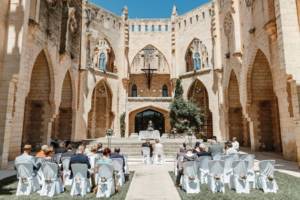
Unfinished church ? This building has undergone changes and remains completely unfinished. And it was designed by one of Gaudi's students. It features architectural elements typical of the Gothic Revival, a noticeable austerity, windows and rose windows, as well as a special magic associated with the fact that it is open to the sky. Beauty, accessed through a small garden !
Cathedral of Santiago de Compostela, Galicia
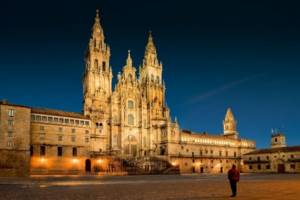
Because numerous pilgrims crossed mountains and valleys to reach this cathedral in the Middle Ages, it is now the most visited cathedral in Spain . This temple, built over the tomb of Santiago, is in the Romanesque style and has a Latin cross plan and three naves with Gothic, Baroque, Plateresque and Neoclassical elements.
This city smells like the Middle Ages!
Mosque of Cordoba, Andalusia
Photo via RayPorres Fotografía
One of the most unique cathedrals in Spain, this is a gem of Umayyad art. Along with the Alhambra in Granada, it is the greatest example of Islamic architecture in Spain . Its swarm of red and white doves forming arches supporting its roofs will leave you speechless.
Cathedral of Burgos, Castile and Leon
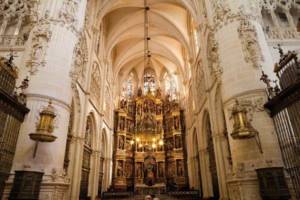
This is the only Spanish cathedral listed as a UNESCO World Heritage Site. It was built between 1221 and 1765, so other styles join the dominant Gothic style. The Spanish national hero Rodrigo Diaz de Bivar and his wife Jimena are buried under its arches. In front of the cathedral there are two beautiful medieval fountains.
For the most historic wedding.
Basilica of Our Lady of Pilar, Zaragoza
Photo via Fotonazos
The most visited of Zaragoza's two cathedrals . This is a Baroque temple with three naves and four towers. Did you know that on the site where the temple now stands there was already a Mozarab church dedicated to Santa Maria? That is why its origin dates back to the 9th century.
Cathedral of Primada Toledo
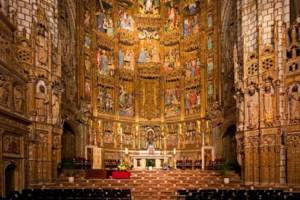
The main cathedral of Spain , this French-influenced Gothic-style temple has a floor plan consisting of five naves supported by 88 columns and 72 vaults. It has polychrome stained glass from the 14th, 15th and 16th centuries, and its choir is considered the greatest in Christendom.
Cathedral of the Good Shepherd, San Sebastian
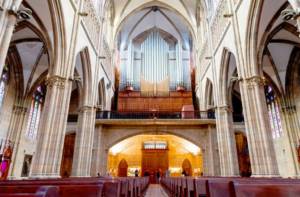
This is the largest religious building in San Sebastian, which towers over the city center and has a needle shape 75 meters high , so it can be seen from almost all points of the capital. It is believed that it is very similar to the Cologne Cathedral, in the likeness of which, as is commonly believed, it was built in the 19th century. It was built from stone masonry from the quarries of Mount Igueldo.
Basilica of the Cathedral of San Salvador, Oviedo
Photo via Viajes Camino de Santiago
You don't know how many relics it contains! Similar to the famous Holy Shroud, a piece of linen cloth that was the cloth covering the face of Jesus Christ during his burial in the tomb .
Getting married here is an honor.


